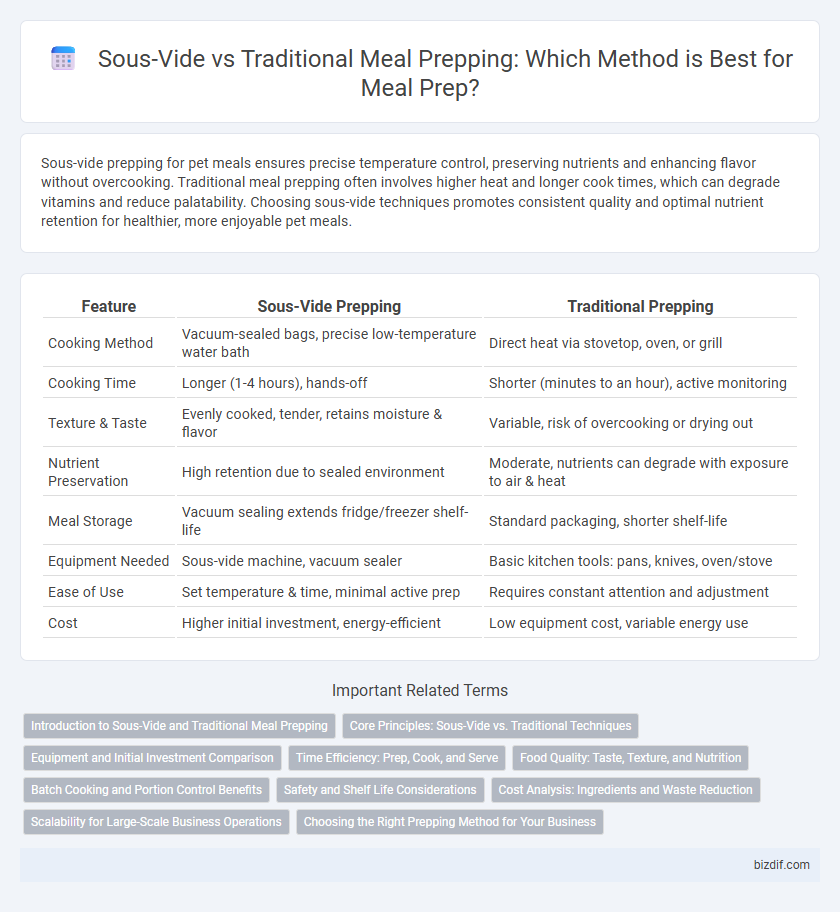Sous-vide prepping for pet meals ensures precise temperature control, preserving nutrients and enhancing flavor without overcooking. Traditional meal prepping often involves higher heat and longer cook times, which can degrade vitamins and reduce palatability. Choosing sous-vide techniques promotes consistent quality and optimal nutrient retention for healthier, more enjoyable pet meals.
Table of Comparison
| Feature | Sous-Vide Prepping | Traditional Prepping |
|---|---|---|
| Cooking Method | Vacuum-sealed bags, precise low-temperature water bath | Direct heat via stovetop, oven, or grill |
| Cooking Time | Longer (1-4 hours), hands-off | Shorter (minutes to an hour), active monitoring |
| Texture & Taste | Evenly cooked, tender, retains moisture & flavor | Variable, risk of overcooking or drying out |
| Nutrient Preservation | High retention due to sealed environment | Moderate, nutrients can degrade with exposure to air & heat |
| Meal Storage | Vacuum sealing extends fridge/freezer shelf-life | Standard packaging, shorter shelf-life |
| Equipment Needed | Sous-vide machine, vacuum sealer | Basic kitchen tools: pans, knives, oven/stove |
| Ease of Use | Set temperature & time, minimal active prep | Requires constant attention and adjustment |
| Cost | Higher initial investment, energy-efficient | Low equipment cost, variable energy use |
Introduction to Sous-Vide and Traditional Meal Prepping
Sous-vide meal prepping involves vacuum-sealing food and cooking it in a water bath at precise temperatures, preserving nutrients and enhancing flavor compared to traditional methods. Traditional meal prepping usually relies on baking, boiling, or sauteing food in bulk, which can lead to nutrient loss and uneven cooking. Sous-vide techniques offer consistent results and longer freshness, making it an efficient alternative for health-conscious meal planners.
Core Principles: Sous-Vide vs. Traditional Techniques
Sous-vide prepping relies on precise temperature control through immersion in a water bath to cook food evenly and retain moisture, nutrients, and flavor, while traditional prepping involves direct heat methods like grilling, roasting, or pan-frying that can cause uneven cooking and nutrient loss. The core principle of sous-vide cooking is maintaining a constant, low temperature for extended periods, preventing overcooking and ensuring consistent texture, contrasting with the rapid, higher heat exposure of traditional techniques. This fundamental difference optimizes food safety and enhances meal quality in sous-vide prepping compared to conventional methods.
Equipment and Initial Investment Comparison
Sous-vide prepping requires specialized equipment such as immersion circulators and vacuum sealers, leading to a higher initial investment compared to traditional meal prepping tools like pots, pans, and basic containers. The precision temperature control in sous-vide equipment ensures consistent cooking results but comes at a premium cost, ranging from $100 to $300 for entry-level devices. Traditional prepping relies on readily available kitchenware with minimal upfront expenses, making it more accessible for beginners or budget-conscious individuals.
Time Efficiency: Prep, Cook, and Serve
Sous-vide meal prepping significantly reduces active cooking time by allowing bulk preparation and low-maintenance cooking, optimizing overall kitchen efficiency compared to traditional methods that require constant monitoring. Precise temperature control in sous-vide ensures consistent doneness, minimizing overcooking and allowing meals to be cooked in advance and quickly reheated, speeding up serving time. Traditional prepping often demands longer active labor and immediate serving to preserve quality, making sous-vide a superior option for streamlined, time-efficient meal preparation.
Food Quality: Taste, Texture, and Nutrition
Sous-vide prepping preserves food quality by cooking ingredients at precise, controlled temperatures, resulting in enhanced taste, consistent texture, and maximal nutrient retention compared to traditional prepping methods. Traditional prepping often exposes food to higher heat and varying conditions, causing nutrient loss, uneven texture, and diminished flavor intensity. Sous-vide maintains moisture and prevents overcooking, ensuring meals retain their original nutritional value and sensory appeal.
Batch Cooking and Portion Control Benefits
Sous-vide prepping offers precise temperature control that ensures consistent doneness and enhanced flavor retention, making it ideal for batch cooking large quantities with uniform quality. Unlike traditional prepping, sous-vide allows vacuum-sealed portions that extend shelf life and simplify portion control, minimizing food waste and promoting balanced meal plans. This method streamlines meal prep efficiency by combining batch cooking's convenience with scientifically optimized preservation techniques.
Safety and Shelf Life Considerations
Sous-vide prepping offers enhanced safety by cooking food at precise temperatures that effectively eliminate harmful bacteria while preserving nutrients. Traditional prepping methods often involve higher heat and variable cooking times, which may increase the risk of uneven cooking and bacterial growth. Shelf life for sous-vide cooked meals typically extends longer due to vacuum sealing and controlled temperatures, reducing spoilage compared to conventionally prepped foods stored in standard containers.
Cost Analysis: Ingredients and Waste Reduction
Sous-vide meal prepping often reduces ingredient waste by enabling precise portion control and extending the shelf life of prepared foods, leading to lower overall grocery expenses. Traditional prepping may incur higher costs due to inconsistent portion sizes and greater spoilage rates, increasing food waste and frequent repurchasing. The initial investment in sous-vide equipment can be offset by long-term savings through efficient ingredient use and minimized waste.
Scalability for Large-Scale Business Operations
Sous-vide prepping offers precise temperature control and consistent cooking results, making it highly scalable for large-scale business operations requiring uniform quality and reduced food waste. Traditional prepping methods often involve manual steps and variable cooking times, which can hinder efficiency and consistency when scaling up. Implementing sous-vide allows businesses to streamline production, improve inventory management, and meet high-volume demand with reduced labor costs.
Choosing the Right Prepping Method for Your Business
Sous-vide prepping offers precise temperature control and consistent results, making it ideal for businesses aiming to maintain high food quality while reducing waste and labor costs. Traditional prepping methods provide faster turnaround and flexibility for varied menu items but may result in variable cooking outcomes and higher resource use. Selecting the right meal prepping method depends on your business's volume, staffing, menu complexity, and quality standards to optimize efficiency and customer satisfaction.
Sous-vide prepping vs traditional prepping Infographic

 bizdif.com
bizdif.com